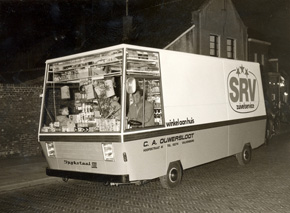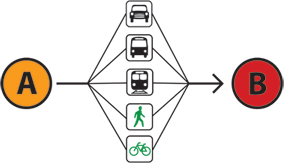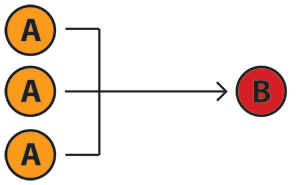| |
| Method 2: Diagrammatic Approach |
|
Another way of looking at city travel is by way of examining the three elements in the diagram on the right (fig 3), where A is the origin of travel, the arrow being the mode and route, and B the destination. This simple diagrammatic approach leads to a very clear framework that can be directly applied to policy, design and communication challenges. It helps to frame thinking about transportation in a very elementary manner and thus come up with solutions that address the root of the issue, rather than more entangled issues. For each and every journey imaginable we could apply this framework and see if there is an alternative. This also helps to determine solutions for RD, DD and DM type travel (discussed on page 1).
|

fig. 3 |
The Arrow
The way we can subsequently deal with this diagram is by investigating the possibilities for each element. Let’s start with the arrow, the journey itself. We could just remove the arrow, and be rid of the whole problem (fig. 4). How can we achieve this? The removal of travel can imply that the travel by itself was not necessary, therefore this can usually only be applied to desire travel. But that is just a small part of all travel. What else can this be used for? One could, without removing the workplace (b) or the home (A) remove travel by introducing a one-day-work-at-home scheme. Small things matter as well. If you run an analysis of all travel performed in the day by all people, eventhough they were required travel officially, you might find that many of these journeys are unnecessary. Going to the store twice because you have forgotten something. Going around the city one more time because you got lost. For many of these unnecessary travels that are not particularly desirable we can find a possible solution. GPS navigation systems, A shopping list. Whatever it is, it will only happen once it becomes ingrained in the culture of our society that travel is a precious event. It is expensive in terms of energy, one of the most energy expensive things we do. When the oil prices continue to rise, the effects of this will become self evident.
|

fig. 4 |
The Destination
Now let’s look at B. We can get rid of the arrow as well by bringing the destination to the origin (fig 5). What sort of solutions does this imply? Think about the commute. One travels to the same place each day to perform a certain set of actions for most of that day, and then return to where you came from. In reality this is not a very natural flow, depending on the type of work. One can instead work at home just as well for many types of jobs, and this becomes increasingly more feasible with networking technologies developing. On an urban design level we can encourage this by requiring residential buildings to make work space available in houses. Pushing this to another level, such as has been done in the Borneo Sporenburg development in Amsterdam by West 8, one can provide flexible space in each house to be used as a shop, office, or living space, depending on who lives there. The space is easily converted and adapted for different uses. Not only does this provide the potential for less travel, it makes for high quality living spaces, a more vibrant street life with shops and small businesses, and creates a mixed demographic that is harder to achieve in less diverse neighborhoods.
One more imaginative solution for this regarding shopping is the Dutch SRV car (fig 6). It’s a convenience store on (electric) wheels, which has its origins in the milk man delivery donkey carts. In the 50’s and 60’s these were quite popular, created by a network of merchant companies. Some of these electric vehicles still operate today and provide a big resource for elderly people and for those living in small rural villages that do not have a store of their own.
|

fig. 5

fig. 6. SRV electrical driving convenience store in the Netherlands. They were typically built by Spijkstaal but models from Hoogstra, Rengocar and others exist.
|
The origin
Somewhat analogous to the description above, we can move the origin to the destination (fig 7). Examples of these would be boarding schools in remote areas rather than long student commutes, moving closer to work, and encouraging this. In China for instance it is common for large companies to provide residences for their employees close by. Other examples include living in dense metropolitan areas where most needs are only a short stroll away, and the people density allows for friends to be much closer to one another.
|

fig. 7 |
Other methods
Other than the three options mentioned above, we could envision the journey itself taking a different form, rather than disappearing (fig 8). We could for instance see how the journey becomes an electronic instead of a physical one, such as creating more administrative services on the internet rather than in person, such as motor vehicle registration, taxes, and other governmental necessities.
Also, the way the categorical system looks at things can be formed in a diagram where the choice between modes for the journey is captured, and preferential modes be selected (fig 9.). Lastly we could see modifications on the diagram such as fig 10 which expresses multiple origins or destinations to be merged to allow for more efficient public transportation, or carpooling.
Final words
These methods can guide designers and policy developers in organizing thoughts and discussions about transport issues. They are however not a substitute for research into specific problems. Abstraction is a very powerful conceptual tool, but in order to fully comprehend a specific situation all factors will need to be mapped and laid bare for analysis.
In the future we might develop more methods to look at different parts of the tranport problem. A method to analyze the very important and inhibiting love for the automobile would be in place. Public transportation would need to change quite a bit in its operation, experiential nature, flexibility and network before it can truly compete with a car in terms of comfort, privacy and flexibility.
A related article to this is the Pedestrianization Tools Survey. It can be used to augment solutions found using these methods and investigates on a material level what can be achieved with very simple and affordable interventions in the public realm to reduce reliance on the automobile. |

fig. 8
 fig. 9 fig. 9

fig. 10
|
| |
|
| |